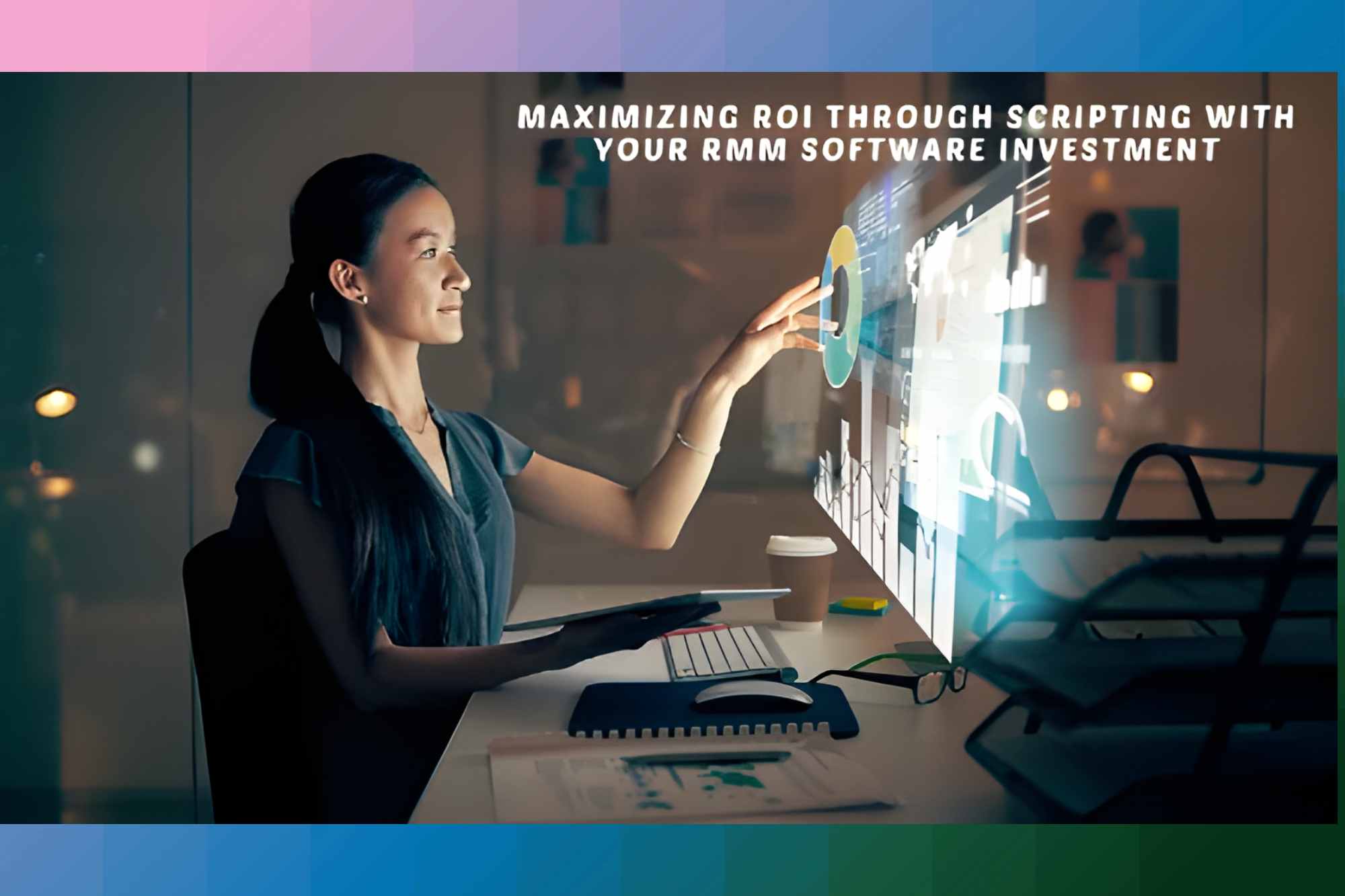Remote Monitoring and Management (RMM) software has become an invaluable tool for modern businesses to efficiently manage their IT infrastructure and systems. Capabilities like automation, patching, monitoring, and more empower RMM to help businesses optimize operations and reduce costs. However, to truly maximize return on investment (ROI) from RMM software, thoughtful implementation of scripting is key.
Scripting allows you to customize RMM to align with your specific business needs through the automation of repetitive tasks. With the right strategies, scripting can help unlock the full potential of your RMM investment. Let’s explore best practices for implementing effective scripting to drive maximum ROI.
Table of Contents
The Power of Scripting in RMM Software
Scripting is what transforms RMM software from a passive monitoring tool into an engine for automation and optimization. With scripting, you can program your RMM platform to automatically carry out tasks like patching, software deployment, system maintenance, and more based on predefined triggers and schedules. This eliminates the need for technicians to manually complete mundane, repetitive tasks which are prime candidates for automation.
For example, scripting enables RMM software to proactively monitor systems and resolve issues through automated responses when specific conditions are detected. If CPU usage spikes on a server, a script can automatically restart processes to resolve the issue without human intervention.
Scripting also allows RMM platforms to handle software and OS patch deployments across an entire IT environment seamlessly according to set schedules. Rather than manually updating each endpoint, scripts systematically roll out patches staged with minimal disruption.
These are just a couple of examples of the automation power unlocked by scripting within RMM software. Virtually any repetitive IT process – from system configurations to new user setups – can be optimized through scripting. This drives efficiencies and cost reduction across the board. With robust scripting capabilities, issues like low disk space, failed services, or security threats can trigger automated remediation scripts.
By utilizing monitoring data and event alerts as inputs, RMM scripting enables the creation of true lights-out IT management processes. The power of scripting lies in its ability to customize automation capabilities to each organization’s specific environment and needs.
Strategies for Effective Scripting Implementation
To maximize the impact of RMM scripting efforts, a strategic approach to implementation is crucial. Here are some expanded best practices to ensure your scripting drives maximum efficiency and ROI:
- Conduct a Process Assessment: Take time upfront to map out existing IT workflows and processes thoroughly. Identify areas of inefficiency, repetition, or frequent issues that could benefit most from scripted automation. Prioritize these high-impact opportunities first.
- Design Integrated Scripts: Streamline scripts to target many agents and systems in one integrated process versus siloed scripts. For example, use PowerShell to script endpoint patching integrated with network monitoring and alerting.
- Implement Staged Rollouts: Test automation scripts extensively in lower environments first. Then roll out methodically group by group, fixing issues as they arise. Gradual implementation minimizes disruption.
- Utilize Triggers and Alerts: Configure scripts to auto-launch when specific events, thresholds, or conditions are met in the RMM system. This enables true lights-out automation.
- Implement Access Controls: Limit write-access for scripts to only authorized administrators. Read-only access to the help desk enables monitoring without the risk of unwarranted changes.
- Optimize Scheduling: Schedule script runs during periods of low network activity to minimize resource load. Also allows the ability to schedule or trigger scripts manually on-demand.
- Monitor Performance: Continually monitor the impact and effectiveness of automation scripts using ROI metrics. Tweak and refine over time to improve results.
These strategic best practices will help you maximize the ROI benefit of RMM software scripting within your unique environment. Taking an integrated approach is key for long-term value.
Maximizing ROI through Effective Scripting
While scripting provides the tools to automate processes, the real ROI comes from strategic implementation. Here are some best practices for maximizing returns from your RMM scripting efforts:
- Prioritize High-Impact Areas: Focus first on automating costly, time-intensive tasks like software deployments, patching, and onboarding/offboarding rather than one-off issues. Go after the heavy hitters.
- Tailor Scripts to Business Goals: Ensure scripts align directly to KPIs like reduced downtime, faster resolution times, and improved client satisfaction. Tie scripts to targeted outcomes.
- Optimize Rigorously: Continually refine scripts after implementation to improve efficiency. Monitor for redundancies across scripts that can be consolidated.
- Implement Incrementally: Start with quick wins like automating alerts and notifications then expand scope over time. The stepped implementation ensures smooth integration.
- Track Granular Metrics: Monitor metrics like time savings per script, instances automated, and error rates to quantify ROI impact.
- Maintain Access Controls: Script oversight, change control audits, and access limitations reduce the risk of unvetted changes undermining ROI.
- Focus on Sustainable Change: Look beyond quick returns and target changes that improve IT operations over the long term.
With an effective, focused approach to RMM scripting that directly aligns with core business goals, you can continually maximize the value derived from automation capabilities. The key is precision and strategy.
Key Metrics for Measuring ROI
To analyze the true impact of RMM scripting on your business, you need to identify and track relevant ROI metrics that include:
- Time savings: Calculate time spent previously on manual tasks now automated through scripting.
- Error reduction: Monitor script success rates and reduction in human errors/rework.
- Improved system performance: Measure optimization in factors like uptime/availability, lag, and failures.
- Cost reduction: Track decreases in labor, downtime losses, and other operating costs.
- Revenue increase: Identify new revenue enabled by the time savings and efficiency gains.
Overcoming Challenges and Pitfalls
While impactful, scripting does come with potential implementation challenges, such as:
- Disruptions from poorly optimized scripts Hinder existing processes and workflows
- Increased loads on systems and networks
- Security risks from unauthorized access and unvetted code
Using practices like access controls, infrastructure monitoring, staged rollouts, and testing automation scripts in lower environments can help overcome these pitfalls. Signing scripts and certificates also reduces errors, while documenting processes address continuity issues caused by staff turnover. Being adaptive and responsive is key.
Best Practices for Continuous Improvement
Maximize your ROI over the long term by continually optimizing and adapting scripts to evolving business needs.
- Maintain a change log for scripts to simplify troubleshooting, updates, and auditing.
- Monitor script performance using ROI metrics, and tweak as needed.
- Utilize RMM scripting assistance tools like ConnectWise SidekickTM for easy script creation.
- Automate Tier 1 support issues to focus resources on high-value initiatives.
- Develop staff skills and knowledge through scripting training and collaboration.
Conclusion
RMM software is a powerful IT management tool. To maximize your ROI from RMM investments, strategic implementation of scripting for automation is crucial. Follow the tips and best practices outlined to streamline processes, drive efficiency, and enhance visibility through custom scripting tailored to your unique needs. With the right approach, you can unlock the full potential of your RMM software through innovative scripting capabilities that provide long-term value.
Key Takeaways
- Scripting allows you to customize RMM software to match unique business needs and drive efficiencies.
- Strategic implementation and standardized scripting practices are essential for maximizing ROI.
- Relevant metrics must be tracked to measure the ROI impact of scripting efforts.
- Optimization and continuous adaptation of scripts are key to sustaining long-term ROI benefits.
Through innovative scripting strategies that align with your specific environment, you can unlock the automation capabilities of RMM software to enhance visibility, empower users, and maximize your return on this pivotal IT investment.
FAQs
1. How can RMM scripting benefit companies of different sizes?
Scripting in RMM software is scalable, allowing both SMBs and large enterprises to realize benefits through automation. The key is tailoring scripts to target high-impact areas and seamlessly integrate with existing workflows. With the right strategy, any organization can maximize ROI.
2. What are some common misconceptions about RMM scripting?
Some see scripting as overly complex and requiring heavy coding skills. But modern RMM platforms have intuitive, user-friendly scripting tools accessible to all technical skill levels. Scripting also facilitates innovation beyond basic task automation. With training and planning, scripting can deliver transformative ROI.
3. How is security ensured when scripting within RMM software?
Security should always be a priority. Follow best practices like role-based access, multi-factor authentication, encryption, vetted script repositories, isolated testing environments, and adherence to regulatory compliance standards. Audit logs also enable tracking script activities and changes.
Please explore our site for more exciting content if you like this article.





